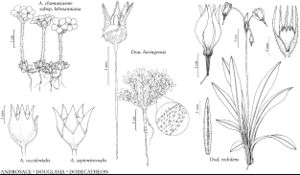Androsace
Sp. Pl. 1: 141. 1753.
Gen. Pl. ed. 5, 69. 1754 ,.
Herbs usually annual or perennial, rarely biennial, sometimes cushion- or mat-forming, rarely slightly succulent. Rhizomes absent; roots fibrous or a slender taproot. Stems ascending, simple. Leaves in single or multiple basal rosettes, simple; petiole absent or obscure, slightly winged; blade lanceolate to spatulate or cuneate, base attenuate, cuneate, or truncate, margins entire or moderately dentate, apex acute to obtuse (often dentate), surfaces usually hairy, hairs grayish white, simple or forked. Scapes 1–25. Inflorescences umbels, 2–20-flowered, involucrate; bracts 1–10. Pedicels absent or erect to arcuate, elongating with age. Flowers homostylous; sepals 5, green, calyx broadly campanulate to subglobose or hemispheric, ± 5-angled, not keeled, glabrous, pilose, or puberulent, lobes shorter than tube; petals 5, white, sometimes fading to pink in age [pink to shades of red], corolla campanulate to salverform, tube yellow, ± inflated, lobes shorter than tube, apex emarginate to entire; stamens included; filaments indistinct, very short; anthers not connivent. Capsules globose to subglobose, valvate, dehiscent nearly to base. Seeds usually 3–4 in perennial species, 20–50+ in annual species, brown, 4-angled to somewhat trigonous, reticulate to almost smooth. x = 10.
Distribution
North America, nw Mexico, Eurasia, mostly north-temperate areas.
Discussion
Species ca. 100 (5 in the flora).
Androsace is chiefly Eurasian, with its greatest diversity in China, where over 70 species occur. It is a popular rock garden genus with many horticultural representatives. One of these, A. maxima, an annual Eurasian species growing as a single rosette, was reported in the late 1800s as an introduction near Yonkers, New York. We have no recent records that suggest this was anything more than an ephemeral horticultural escape.
Selected References
Lower Taxa
Key
| 1 | Plants perennial, mat-forming; leaves in multiple rosettes. | Androsace chamaejasme |
| 1 | Plants annual or biennial, not mat-forming; leaves in single rosette | > 2 |
| 2 | Involucral bracts relatively broad, ovate to lanceolate | > 3 |
| 2 | Involucral bracts relatively narrow, lanceolate to linear-lanceolate | > 4 |
| 3 | Calyx lobes subulate, stiffly erect, apex prominently acute | Androsace elongata |
| 3 | Calyx lobes broadly lanceolate, erect, apex acute to obtuse | Androsace occidentalis |
| 4 | Leaf blade bases abruptly narrowed to petiole; plants of wet areas. | Androsace filiformis |
| 4 | Leaf blade bases obscurely narrowed to petiole; plants of moist to dry areas. | Androsace septentrionalis |
